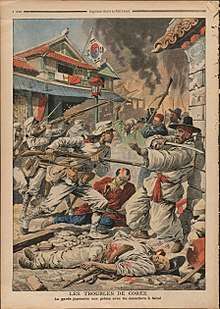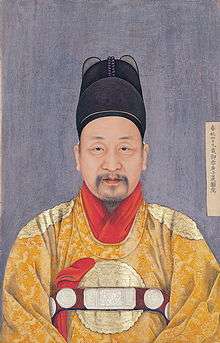Namdaemun Battle
| Namdaemun Battle | |||||
|---|---|---|---|---|---|
| |||||
| Belligerents | |||||
|
|
| ||||
The Namdaemun Battle was an insurgency by the Korean army against Japanese forces in Korea. It is a reaction to the disbandment of the Korean army following the Japan-Korea Treaty of 1907. It took place at Namdaemun Gate in Seoul on August 1, 1907.
Overview

In June 1907, the Imperial Japan forced the Sunjong Emperor disbanded the Armed Forces of the Korean Empire. As a consequence, the Armed Forces of the Korean Empire went on a revolution with arms.[1]
The location of the Battle of the Armed Forces of the Korean Empire is the site and street where the battle exploded, which corresponds today to the current location of the Korean Chamber of Commerce and Industry.
Because of an important unequilibrium between numbers of soldiers in both side, Korean forces did not overcome their inferiority, and the Korean base was therefore occupied by Japan. The disbanded army joined the Righteous Armies and together they solidified a foundation for the Righteous Armies’ Battle of 1907.
This led to the Anti-Japanese War of the Righteous Armies.
Historical context and Description

In 1906, the installation of the Japanese Resident-General directed by Prince Ito Hirobumi in Korea. The Japanese Resident-General of Korea was installed in 1906, during the 44th year of the King Gojong’s reign. After this event, Imperial Japan hurried to annex Joseon, which is the Joseon dynasty at the time of the Korean Empire of Dai Han.
As a matter of fact, Japan forced Emperor Gojong to abdicate the throne of Korea in June 1907. This was possible because of the Hague Secret Emissary Affair, also called the Jeongmi Treaty, which concluded the Japan-Korea Treaty of 1907. The treaty disbanded the Armed Forces of the Korean Empire, which was the last military force.
On August 1 at 8 am, the 1st Battalion (unarmed 1st Infantry Regiment) was about to depart for the training center where the disbandment ceremony was supposed to happen.
The 1st Battalion Commander Major Park Sung-hwan (1869-1907), wrote a note on a paper and committed suicide by shooting himself. The note said that he was against the disbandment of the armed forces.
His suicide enraged the soldiers, which extorted ammunition and armaments, arranged sentries around the barracks and started to open fire with guns against the Imperial Japanese Army.
The 2nd Infantry Regiment or 1st Battalion inside Sungnyemun Gate, heard the gunshots around Seosomun Gate, they directly came and opened as well fire on the Imperial Japanese Army.
Around 9:30 am, the Imperial Japanese Army put its 51st Infantry Regiment, first second and third Battalions, to fire indiscriminately with machine guns installed on the rampart of Sungnyemun.
Without any surprise, the Korean forces were in a numerical inferiority, and it was impossible for them to overcome the armament and soldiers imbalance. Therefore, the Namdaemun Barracks was occupied around 10:50 am and the Seosomun Barracks was taken by the Imperial Japanese Army around 11:40am.
A major part of the Korean Empire Armed Forces kept on resisting outside Seosomun Gate. As well, the disbanded soldiers joined the righteous armies to fight. They strengthened a foundation for the Righteous Armies’ Battle of 1907, which phenomenon led to the Anti-Japanese War of the Righteous Armies.
The geographical map of Gyeongseong in 1903, shows that the Barracks of the 1st Battalion (currently 120 in Seosomun-dong) and the Barracks of the 2nd Battalion (currently 34 in Namchang-dong), were located in the southeast of Seosomun Gate and Sungnyemun Gate respectively.
Seosomun and Sungnyemun are the place where the street battle exploded. This site now corresponds to the current Korea Chamber of Commerce and Industry.
Analysis
The Battle of Namdaemun against Japan is to resist from dissolution of the Korean army.
From an international point of view, the battle is seen as simple combat because of the small size of the Korean Forces. Indeed, korean soldiers were only 3,000 fighting during this battle.
On another hand, from a national korean point of view, this event was huge because almost all of the capital guards were committed in it. As a matter of fact, there were 20,000 Korean soldiers in the country and only 4,000 in the capital city.
References
- ↑ Seth, Michael J. (2010-10-16). A History of Korea: From Antiquity to the Present. Rowman & Littlefield Publishers. ISBN 9780742567177.